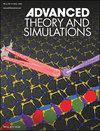Surface Elasticity Based Nonlocal Vibration Analysis of Bidirectional Functionally Graded Tapered Nanobeam
IF 2.9
4区 工程技术
Q1 MULTIDISCIPLINARY SCIENCES
引用次数: 0
Abstract
The present paper proposes the impact of the mutual interplay of nonuniform geometry with surface and nonlocal stresses on the vibration characteristics of bi-directional functionally graded tapered nanobeam with surface layers. The material composition of nanobeam is assumed to follow a power-law distribution along the thickness and exponential along the length. The nonuniformity in the geometry of nanobeam arises due to the linear variation of thickness along its length. The considered nanobeam is modeled as a Timoshenko nanobeam with surface layers of negligible thickness. The nonlocal and surface effects are incorporated using Eringen's nonlocal theory with Gurtin-Murdoch's surface elasticity theory. Hamilton's energy principle is employed to derive the nonlocal equations of motion with boundary conditions. The differential quadrature method is exploited to obtain the natural frequencies and the convergence of the method is demonstrated. A parametric study is introduced to investigate the influence of critical parameters such as taper parameter, surface parameter and nonlocal parameter on the vibration characteristics of bi-directionally graded nanobeam. This work explains that the nonuniformity in the geometry of nanobeam significantly influences the frequency range of tapered nanobeam with surface layers. These results will serve as a benchmark for future work on nonuniform nanostructures.

基于表面弹性的双向功能梯度锥形纳米梁非局部振动分析
本文提出了非均匀几何与表面和非局部应力的相互作用对具有表面层的双向功能梯度锥形纳米梁振动特性的影响。假设纳米梁的材料组成沿厚度呈幂律分布,沿长度呈指数分布。纳米梁的几何不均匀性是由于厚度沿长度的线性变化引起的。所考虑的纳米梁被建模为具有可忽略厚度的表层的Timoshenko纳米梁。采用Eringen的非局部理论和Gurtin-Murdoch的表面弹性理论将非局部和表面效应结合起来。利用哈密顿能量原理推导了具有边界条件的非局部运动方程。利用微分正交法求出固有频率,并证明了该方法的收敛性。采用参数化方法研究了锥度参数、表面参数和非局部参数等关键参数对双向梯度纳米梁振动特性的影响。本文解释了纳米梁几何形状的不均匀性对带表面层的锥形纳米梁的频率范围有显著影响。这些结果将作为未来非均匀纳米结构研究的基准。
本文章由计算机程序翻译,如有差异,请以英文原文为准。
求助全文
约1分钟内获得全文
求助全文
来源期刊

Advanced Theory and Simulations
Multidisciplinary-Multidisciplinary
CiteScore
5.50
自引率
3.00%
发文量
221
期刊介绍:
Advanced Theory and Simulations is an interdisciplinary, international, English-language journal that publishes high-quality scientific results focusing on the development and application of theoretical methods, modeling and simulation approaches in all natural science and medicine areas, including:
materials, chemistry, condensed matter physics
engineering, energy
life science, biology, medicine
atmospheric/environmental science, climate science
planetary science, astronomy, cosmology
method development, numerical methods, statistics
 求助内容:
求助内容: 应助结果提醒方式:
应助结果提醒方式:


